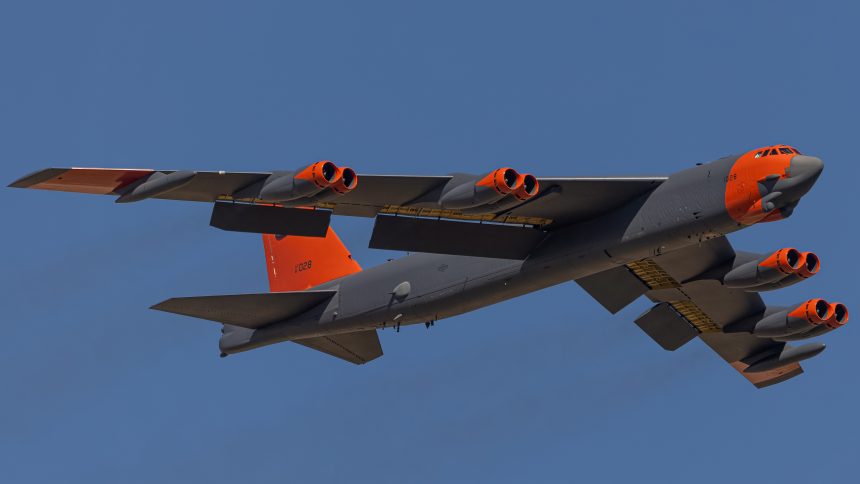The B-52H 61-0028 has the forward fuselage, wings near the wingtips, engine nacelles, and vertical stabilizer painted in dayglo orange, contrasting the typical dark gray paint of the Stratofortress.
A U.S. Air Force B-52H Stratofortress bomber has been spotted sporting an amazing retro color scheme recently. The BUFF (Big Ugly Fat Fellow) was photographed taking off from Tinker Air Force Base, Oklahoma, home of the Oklahoma City Air Logistics Complex, by our friend Rob Stephens at Redhome Aviation, on Sept. 30, 2024.
We reached out to Rob who provided us a lot of additional details about this cool paint job.
“Somewhere around the middle of September 2023, B-52H 61-0028 arrived at Tinker AFB after a training sortie,” he told us in an email. “I don’t have the full details and the damage appears far below what would necessitate an Accident Investigation Board, but I understand the flaps were over sped sometime before the landing at Tinker. Scuffs and dents are visible on the side of the aircraft, as if the flaps made physical contact with the fuselage. Crews from Barksdale were dispatched to Tinker to inspect the aircraft and prepare her for the flight home”.
On Sept. 22, 2023 the B-52 was flown back to Barksdale Air Force Base, Louisiana, “with her flaps-up, making quite the stunning departure”, says Stephens.
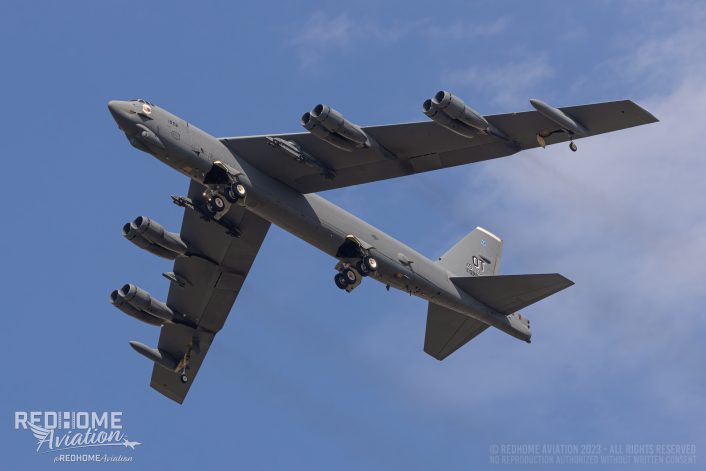
“One of the greatest things about living where I do is being able to photograph the fantastic work of the 565th Aircraft Maintenance Squadron as the B-52s go through programmed depot maintenance. While a rare occurrence, there are times where the aircraft will fly “naked” without paint between completion of PDM (Programmed Depot Maintenance) and their appointment for paint.”
PDM is a very complex process that each B-52 undergo every four years, made of heavy checks, during which the aircraft is almost completely disassembled and each part is inspected and all defects are fixed before they are rebuilt and sent back to their home stations as they were (almost) brand new. Even the paint is stripped off the entire airframe so that technicians can analyze every part of the aircraft and make repairs where needed.
B-52H 61-0028 “Wolfpack” flew on Aug. 26, 2024 mostly without paint and an orange rudder, that showed she was headed towards a special paint job.
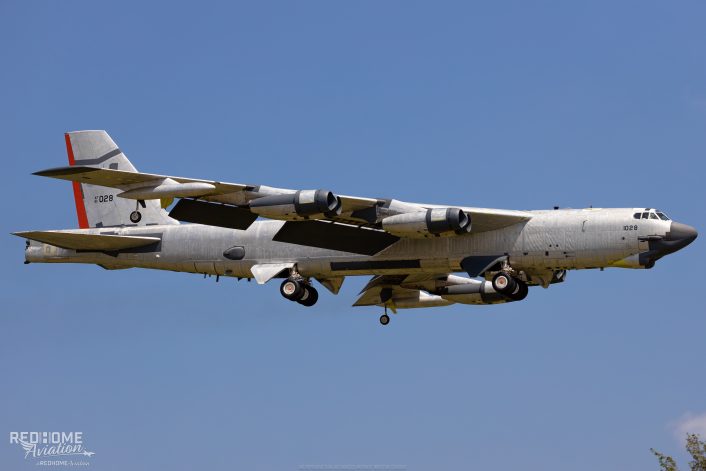
“The final paint scheme on 61-0028 is a heritage back to the early days of the [NASA] B-52 testing campaigns, such as NB-52A 52-0003, which carried the North American X-15 in 1959. This paint is similar to the famous NB-52B 52-0008, but more closely resembles 52-0003. Her forward fuselage, wings near the wingtips, engine nacelles, and vertical stabilizer are painted in dayglo orange, contrasting the typical dark gray paint of the Stratofortress. Her “OT” and “49 TES” tail markings, black arrow point on the tail, and “U.S. Air Force” on the fuselage will be applied while she is at Barksdale AFB, LA.”
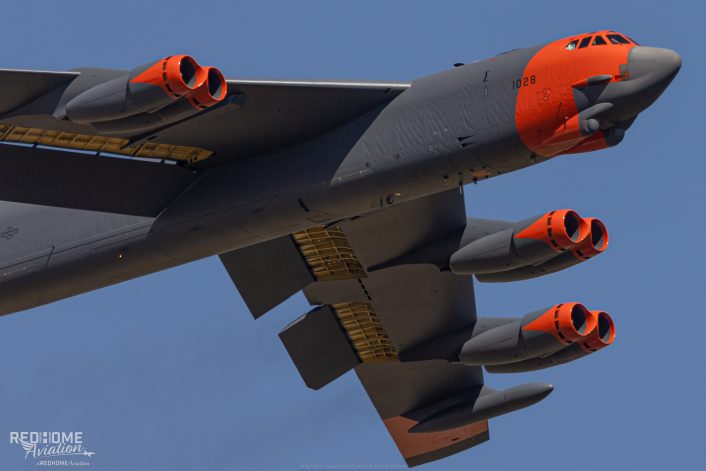
The NB-52s
In mid-1957, NASA decided to switch the launch aircraft (or “mothership”) for the X-15 hypersonic research project from the B-36 Peacemaker to the B-52 Stratofortress. The B-36 was nearing the end of its service life, and it was anticipated that maintaining a single B-36 after its retirement would be difficult due to the lack of spare parts. As the X-15 program moved forward, the NB-52A and NB-52B Stratofortresses were selected to serve as the launch platforms, with the NB-52B 52-0008 continuing in this role until its final mission in November 2004, while the NB-52A 52-0003 was retired earlier in 1969.
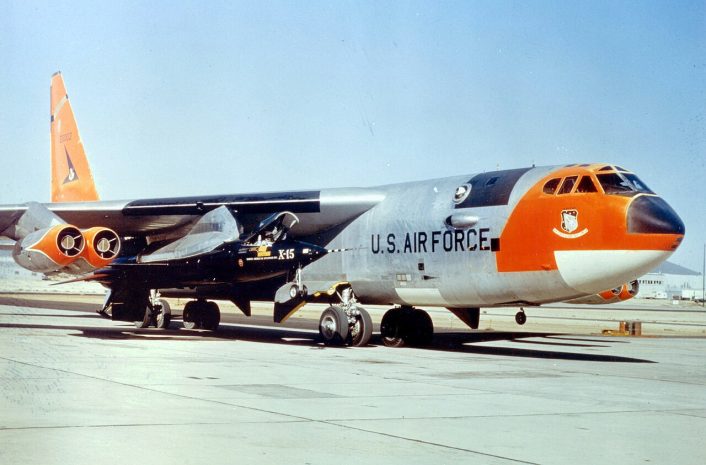
The NB-52B essentially functioned as a flying launch pad, operating at altitudes of nine miles to provide the necessary propellants, gases, and electrical power to the rocket planes it carried. To enable this, the aircraft’s right wing was reinforced and fitted with a pylon capable of supporting payloads exceeding 50,000 pounds—about a fifth of the aircraft’s own weight. This capacity made the Stratofortress an invaluable tool for numerous aeronautical research projects, including those that eventually influenced the Space Shuttle program.
The re-engineered NB-52B helped prove the viability of the Space Shuttle’s steep gliding landings by launching several wingless lifting bodies, which demonstrated the feasibility of such an approach. Additionally, the NB-52B played a critical role in testing parachutes that recovered the Space Shuttle’s solid rocket boosters and the drag chute used during Shuttle landings. Despite the aircraft’s age and rising maintenance costs, it continued to be used for various advanced research programs, including launching remotely piloted vehicles, drones, and experimental payloads in the 1970s and 1980s.
Beyond its role in launching aircraft, the NB-52B also contributed to research on wake turbulence, served as a gunnery target, and tested pollution-reducing fuel additives, once flying as a ten-engine jet with additional engines mounted beneath the bomb bay. Notably, during the X-38 program, it deployed the largest parafoil in history, which had a surface area larger than a Boeing 747’s wing.
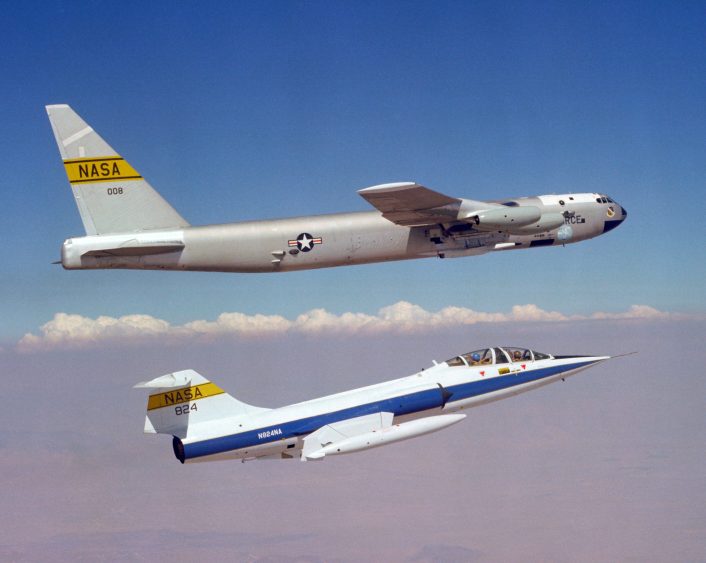
The NB-52B’s final mission was in 2004 when it launched the X-43A, which achieved Mach 9.6 with the world’s most powerful air-breathing engine. After decades of service and a vital contribution to aviation and space research, the aircraft was officially retired on December 17, 2004, at a ceremony at NASA’s Dryden Flight Research Center.
At the time of its retirement, “Balls 8” (from its NASA tail number, 52-008, where the leading zeroes and the final digit are commonly referred to as “Balls” in military slang) was the oldest B-52 still in active service and the only one not of the H model. It also had the fewest total flight hours of any operational B-52.
The aircraft is now on permanent public display near the north gate of Edwards Air Force Base in California.
The Oklahoma City ALC
As mentioned earlier, Rob Stephens lives near Tinker AFB, allowing him to photograph the aircraft undergoing PDM at the Oklahoma City Air Logistics Complex. The Oklahoma City Air Logistics Complex is a key unit within the Air Force Materiel Command and the largest single-site employer in Oklahoma, with over 9,000 military and civilian personnel delivering combat power for the nation. This massive complex is responsible for programmed depot maintenance and modifications on aircraft like the KC-46, KC-135, B-1B, B-52, E-3, and Navy E-6. It also handles maintenance, repair, and overhaul of engines including the F100, F101, F108, F110, F117, F118, F119, F135, and TF33, supporting not only the Air Force but also the Navy, Marine Corps, and foreign military sales. In addition to its maintenance and repair work, the complex develops and sustains mission-critical software for the Air Force and other customers, and it provides worldwide aircraft battle damage repair for multiple weapon systems.
The complex is comprised of four groups working together to provide top-tier maintenance and support. The 76th Aircraft Maintenance Group specializes in depot maintenance for B-1, B-52, KC-135, E-3, E-6, and special mission fleets, offering full overhaul services, FAA-certified repairs, modifications, and flight testing. The 76th Commodities Maintenance Group manages depot-level maintenance of aircraft and engine parts for a wide range of systems, including the A-10, B-1, B-52, C-17, F-15, F-16, and more, and serves as the Air Force Technology Repair Center for air and fuel accessories. The 76th Maintenance Support Group ensures the continuous operation of one of the Department of Defense’s largest industrial complexes, maintaining facilities, tools, and equipment needed for the depot’s mission. Lastly, the 76th Propulsion Maintenance Group is the leading DoD engine repair and overhaul center, responsible for maintaining engines used in bombers, tankers, fighters, and special mission aircraft.
Originally redesignated as the 76th Maintenance Wing in 2005, the organization was inactivated in 2012 when the Oklahoma City Air Logistics Center was restructured as the Oklahoma City Air Logistics Complex. The complex now operates under the Air Force Sustainment Center at Tinker AFB, one of three key sustainment centers in the Air Force.

